African Adventures: Madagascar and Uganda
I've always said I don't go on vacation to sleep. Well, today was the definition of living by that motto. With a 4 AM wake up call, we were at breakfast at 4:45 and out the door by 5:30 for our 3+ hour drive from Ranthambore back to Jaipur. The drive was fairly uneventful (I think I took a nap at one point) and the chaotic (yet organized) traffic of Jaipur welcomed us back. From there, we took a 7 hour flight to Nosy Be, Madagascar... where we then hopped in buses for our one hour drive to the hotel. Are you exhausted reading that? Me too.
Nosy Be is a small island off Madagascar's northwestern coast that is arguably Madagascar's number one beach destination. With soft white sand, turquoise waters, and seafood, most visitors find paradise in its water-based activities and sunny climate. Also known as "the perfume island", Nosy Be has long been a meeting place for merchants, explorers, and settlers from various countries. While the island's first inhabitants were the Sakalava (a Malagasy ethnic group that continues to preserve its traditions), Nosy Be has seen many influences, notably Arab and Swahili, before becoming a French colony in the 19th century. In 1842, the French seized the island and named it "Nossi-Be" or "The Pearl of the Indian Ocean". France left a deep imprint on the island and French is still commonly spoken. In 1920, the island saw the arrival of a tree of Asian origin called ylang ylang, which revolutionized the agricultural production of Nosy Be. The island quickly became a major oil producer and, due to the ylang ylang, Nosy Be earned its nickname of "the perfume island".
We landed at the tiny airport and drove to our hotel.
By the time we arrived at the hotel, it was almost 5 PM so all we had time for was a quick room tour, dinner, and a shower before bed. See below for our room!
As there are no phones in the room, the resort gives everyone a mobile phone to use while staying there! We ended up using this quite a bit to call reception or get a golf cart.
The following day we opted for a day at leisure at our resort, Ravintsara Wellness Hotel. Facing Sakatia Island on the West Coast of Nosy Be, the property has gorgeous bungalows that are spread out among 12 acres of tropical gardens. See below for some photos around the property!
 |
| This little guy was right outside our room! |
After catching up on rest (and work), we were ready to explore the island the day after... I think we saw all 123 square miles of the island in a single day!
 |
| Our touring route of the island! |
We started our tour by hopping in none other than a pickup truck. Have you ever been anywhere where you tour in a pickup truck? Me either! As we bumped along the dirt roads, we quickly discovered why the pickup truck was needed... We would never have been able to see the places we visited without an all wheel drive.
 |
| Heading towards the Sacred Tree, through narrow and windy roads. |
After a brief stop at some handicraft shops, we headed towards one of three sacred trees on the island. On the coast behind the tiny Mahatsinjo village, there is an enormous sacred banyan tree. Planted by the Queen of the Sakalava tribe in 1836, it is still tradition for the Queen of Nosy Be to make an annual pilgrimage to sacrifice a zebu and gain benediction.
The sacred tree is a symbol of spirituality deeply rooted in Malagasy culture to this day. According to local beliefs, it is the guardian of the ancestors and witnesses traditional rituals and ceremonies as the locals come here to pray, make offerings, and seek the blessings of the ancestors. Considered a link between the terrestrial and spiritual worlds, it is much more than just a religious symbol. The tree also represents Nosy Be's cultural heritage passed down from generation to generation. The tree bears witness to the island's history, traditions, and Malagasy customs. Its presence alone reminds locals of the importance of preserving their cultural heritage and passing on their values to generations to come.
When we arrived, we were dressed in lambas out of respect for the ancestors. A lamba is a traditional garment worn by men and women in Madagascar. Highly emblematic of Malagasy culture, the textile consists of a rectangular length of cloth wrapped around the body. While many locals wear Western clothing, nearly all women will wear a lamba if there is a death or an occasion where prayers are said to the ancestors.
Once we were dressed, we took off our shoes to connect us to the earth, and proceeded inside.
 |
| Entering the Sacred Tree. |
Immediately, we were blown away. A banyan is a fig that develops accessory trunks from adjacent prop roots, allowing the tree to spread outwards indefinitely... and it felt like we were in infinity. Walking through the forest, it felt as though the tree was embracing us, welcoming us. Alone in nature with just the two of us and our local guide, walking barefoot in the forest was one of the most spiritual experiences I've ever had. Some pics below.
 |
| The pathway to the altar. |
 |
| Our local guide at the Sacred Tree. |
 |
| This little guy was on one of the cloths. |
To top it off, as we were approaching the altar, a conspiracy of lemurs approached (don't you love that a group of lemurs is called a conspiracy?? It's like they're up to no good!) They leaped from branch to branch, looking at us with their piercing eyes.
 |
| Approaching the altar. |
 |
| The altar. |
After our visit, we drove back down the winding, bumpy, roads and drove through Andoany, formerly and more commonly known as Hell-Ville. No, it doesn't have a dark past as its name would suggest. Back in the the time of Malagasy royalty, Nosy Be was an integral park of the Sakalava kingdom of Boina. In 1839, Queen Tsiomeko chose to take refuge on the island when the Merina set out to conquer the kingdom. She asked to be placed under the protection of France and, the following year, the Sakalava kings and the Rear Admiral Anne Chrétien Louis de Hell, Governor of Bourbon (now Réunion Island), signed an act of protectorate and the town became named in his honor.
Hell-Ville is a lively, colorful town. Vendors line the street selling food from bananas to fresh fish, and colorful fabrics in every color and pattern sway in the breeze. Here are some scenes from around town!
We drove past the port of Nosy Be towards the village of Marodoka, a former Kiswahili village. On the way, we stopped at a scenic outlook.
This provided a great opportunity to snap a pic of mom in our touring vehicle!!
 |
| Our touring vehicle! Can you spot mom?! |
Marodoka was first established by the first Arab and Indian migrants in the 15th century and, though the village is in ruins, it still boasts colonial architecture with Indian influences as well as a mosque. Here, we stopped at "ghost house", once the home of Karim Djikak (the richest man on the island). Legend says he lived with ghosts he commissioned for his protection! Walking through the house reminded me so much of Cambodia's Angkor Wat, with massive roots clinging to the walls.
By now, it was starting to rain... hard. We drove towards Mont Passot which Nosy Be inhabitants call "Bongo Pisa". Similar to how Hell-Ville got its name, the "Bongo Pisa" was named Mont Passot in memory in Captain Pierre Passot. An officer of the French navy, he was at the origin of the annexation of Nosy Be by France in 1841. Through the rain, we caught glimpses of the nine blue crater lakes of Mount Passot nestled among the ylang ylang. Legend says that the crocodiles that populate the lakes were inhabited by the spirits of the ancient Sakalava kings. Because of this, crocodiles are known as divine creatures. If someone is attacked by a crocodile, it will be said that he has transgressed a fady (taboo). It's forbidden to fish in these sacred lakes, and Mont Passot essentially just serves as the best view of the island (located 1,079 feet above sea level). We went up to go down... Because of the rain, we couldn't see much so we drove back to our hotel where we had some pizza.
After a beautiful beach front dinner for our last night in Madagascar, we packed our bags in preparation for our last stop (and one of my favorite African countries): Uganda.
 |
| Leaving Madagascar. |
Uganda is home to the tallest mountain range in Africa, the world’s longest river, and the continent’s largest freshwater lake (in addition to the world’s second largest inland freshwater lake by size after Lake Superior in North America, though Lake Baikal in Siberia is larger by volume and depth). The “pearl of Africa”, as Winston Churchill called Uganda, is bordered by South Sudan to the north, Kenya to the east, Tanzania and Rwanda to the south, and the Democratic Republic of the Congo to the west. Uganda is a small country by African standards—it’s similar in area to Great Britain—but it hosts 500 plus species of mammal and over 1,000 species of birds. There are at least 32 languages spoken here, but English, Swahili, and Ganda are the most used. Uganda’s religious heritage is tripartite: indigenous religions, Islam, and Christianity. Around four-fifths of the population is Christian, primarily divided between Roman Catholics and Protestants. Around one-eight of the population is Muslim. The remainder practice traditional religions and, as in other parts of Africa, Islam and Christianity have been combined with indigenous religions to form various syncretic religious trends.
Our descent into Entebbe was beautiful. Entebbe is a town on a peninsula in Lake Victoria. It was founded as a garrison post in 1893 and served as the British administrative center of Uganda until 1958. Now, it’s essentially a residential center for government employees.
We deplaned, went through immigration, an exit security screening, walked to the domestic terminal, went through two additional security screenings, and then took a bus to our charter plane. Finally, after receiving a complete tour of the airport with all the walking, we were off to Kihihi (pronounced Key-hee-hee).
We transferred about 90 minutes to Volcanoes Lodge, passing countless banana plantations, rolling hills, and children waving.
By the time we checked into our lodge, we took in our surroundings and relaxed a little before dinner. See below for a room tour...
...And a quick property tour!
 |
| When you enter from the driveway, you step into this room. You then go down a bunch of stairs to the main part of the lodge. |
 |
| Walking towards the dining room/lounge area. |
 |
| Awesome fireplace! |
 |
| I loved these large windows that were open to the forest. |
 |
| The dining room. |
 |
| These windows... |
After dinner, I called it an early night in preparation for tomorrow's gorilla trek. I always joke that I don't go on vacation to sleep, and the following morning was no exception. I woke up at 6 AM, quickly ate breakfast, shoved my packed lunch into my backpack, got fitted with gaiters, and chose a gorilla trekking stick.
 |
| Ready for trekking! |
We loaded the vehicles and drove a few short minutes to the gorilla trekking headquarters where we watched a dance performance by some of the women from the Ride 4 A Woman program (one of my favorite organizations in Africa).
 |
| The entrance to headquarters. |
When their performance was complete, a UWA (Ugandan Wildlife Authority) official briefed us on proper behavior while gorilla trekking. From there, we were assigned our group: the Mubare group.
 |
| Our lead ranger explaining about the gorilla family. |
Funny enough, I trekked to see the Mubare group on my first trip in Uganda in 2022! The Mubare group consists of 8 gorillas and the silverback’s name translates to “prostitute”. Can you imagine naming a gorilla “prostitute”?! I always get a kick out of that. The Mubare family was opened for tourism activities in 1993, making it the oldest habituated mountain gorilla family in the whole of Uganda. The family was first seen on the Mubare Hill which is how it got its name. When I trekked the group in 2022, the walk was mostly flat and we left from headquarters. That was not the case today...
We were the last group to leave from headquarters because the trackers had still not found our gorilla family. Immediately, we knew we were in for a long hike. Gorilla trekking is highly variable, from some treks being as short as 30 minutes to some being as long as 8-9 hours. By 8:30 AM, we were ready to leave and, nearly one hour later, we made it to the start of the trailhead... well, kind of. The vehicle in front of us had a problem with its four wheel drive capabilities, so (being in the second, following vehicle), we had to stop further down the mountain and hike up to the trail before our hike even started.
 |
| Far to the right, you can see our other vehicle. |
 |
| The view from where the car parked. |
At 9:24 AM, we started trekking at an altitude of 5,220 feet. We went up, and up, and up. With no cloud cover, it was a hot hike until we turned into the forest. Due to a combination of the heat, altitude, and vertical incline, this was the hardest gorilla trek I've done out of my treks in Uganda and Rwanda. There were definitely times when I thought to myself, "I'm not going to make it" but I was determined to see the gorillas again, so I sucked it up, gritted my teeth, and put one foot in front of the other. When I thought I couldn't take it anymore, my porter Godfrey asked, "can you hear the gorillas?" I was thinking "No, not really... I'm over here catching my breath, Godfrey" but slowed my breathing down, listened, and heard the gorillas.
We left our bags with our porters, put our masks on, and made the final trek into the dense forest.
 |
| Making the final trek in! |
 |
| You could feel the energy and the excitement! |
Immediately, we came across the silverback mating. This is a rare sight, and while not a photographic one, pretty incredible to say we witnessed. Throughout our hour with the gorillas, we observed the little ones wrestling, grooming one another, and eating. The dense forest made photography difficult, but it's so important to just be in the moment and I came away with a few nice photos, below!
After our hour with the gorillas, it was time to hike back to the vehicles... something I was dreading! At one point, our ranger took us up the most vertical incline I've ever seen. We were huffing and puffing, stopping to rest our calves as we climbed and climbed while trying not to topple over (our porters put a sturdy hand on our backs to help balance us). Much to my dismay, the narrow hike up was solely to have a lunch picnic (by then, I wasn't even hungry), but the view was beautiful...
 |
| View from our lunch spot. |
From the lunch site, it was a quick hike back to the car on a rocky road. Even that walk was gorgeous! In the distance, you could even see the Congo.
 |
| When it's too hot to wear a hat, so you cover your head with a buff... |
And a serious shoutout to my incredible porter!! I literally could not have done it without you, Godfrey!
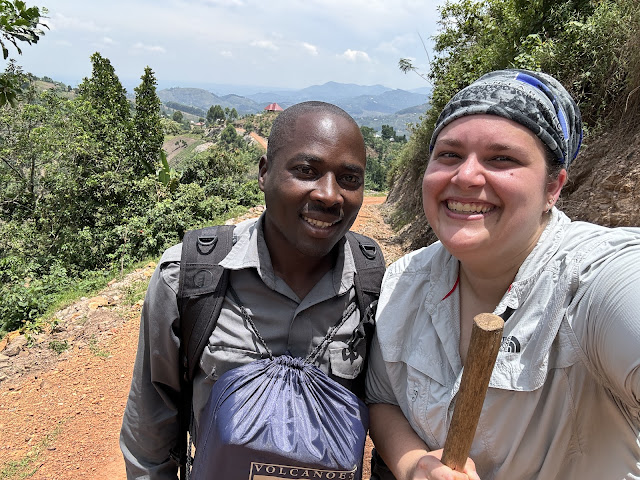 |
| Godfrey and I on the way back to the car. He carried my camera bag AND my lunch sack... he is amazing! |
In typical Ugandan fashion, the drive back was absolutely breathtaking and provided a wonderful moment of reflection on the experience we just had.
Of course, I also had to check my Apple Watch (which was on 2% battery life by the time we had finished the hike!) You'll have to excuse my leftover henna from India... it takes quite awhile to wash off completely!
By the time I got back to the lodge, it was past 2 PM. I had a quick lunch of lasagna before mom and I went on a shopping spree... back to Ride 4 A Woman, of course!
Ever since visiting in 2022, I've been dreaming about going back and today was finally the day. Started in 2009, Ride 4 A Woman has an inspiring history. The founder’s mother sacrificed a lot to put all eight children through school and was always made fun of for having one red dress—she had no money and couldn’t afford the basics for her or her family. She washed her one dress every night so she could wear it the next day and her red dress became the talk of the village. To give back to the community, her daughter founded a program initially focusing on mountain biking and mechanics with the hopes of renting out and maintaining bikes for tourists who visited the area. Three years into the program, the founder met an Australian tourist who knew how to quilt. The tourist taught the women in the village, and subsequently the sewing program was started. The rest of the programs grew from there (agriculture, safe water, microfinance, education, baking, and more) and now 300 women from 11 different villages in the Bwindi community are registered with the organization, including women who have been victims of domestic violence.
They gather at the Bwindi Women’s Community Center to learn while generating an income and the center houses an extensive shop with baskets, aprons, napkins, shopping bags, and so much more. The workshop itself was small, with around 15 sewing machines and a small area for basket weaving. As such, women who work at the center often rotate days at the center. They typically work the standard 9-5 workday and are always provided a hot meal when they are working.
We made a bee-line for the gift shop, where serious shopping damage was done. I purchased beautiful baskets for my fireplace, a basket that I now use as a trash can in my home office, placemats, and a handmade bag to hold all the goodies, of course! With our shopping spree alone, we were able to support nine different women, and I think that is so special. Women supporting women is what Ride 4 A Woman is all about!
 |
| The ladies carrying our purchases! |
 |
| They were very happy! |
We spent some time touring the center, watching ladies make placemats, baskets, and more.
 |
| The main area of the workshop where the ladies sew. |
When we returned to Volcanoes, we laid our goodies out before repacking in anticipation of the long journey home.
 |
| This was our shopping bag!!! |
 |
| Our purchases... |
 |
| A closeup of some of the baskets. |
Here are my baskets at home...
But back to Uganda! Unfortunately, I got a stomach bug again in the evening, and skipped the final day of gorilla trekking. On the bright side, it was nice being at the lodge, sitting on the balcony listening to the forest. By lunch time, I was feeling much better and got a Ugandan "Rolex": a popular street food dish that is an egg omelette with vegetables wrapped in chapati.
After an afternoon at leisure, it was time to eat again. At lunch, we had asked our chef if they could make a traditional Ugandan meal for dinner this evening (I'm certain I got sick from the lasagna... I'm pretty sure locals do not eat lasagna in Uganda!) He happily obliged and he made us the most incredible meal of matoke (mashed plantains) served with chicken luwombo, rice, and ground peanuts— a dish typically served at weddings.
Bellies full, we went to sleep in preparation of our very, very long journey home.
On our final day, we left the lodge by 7 AM and drove back to Kihihi airstrip. We boarded our charter flights for what became the sketchiest flight I've had in Africa: white out with no visibility, rain, and a lot of turbulence. Some of the other planes were delayed due to the weather, but for some reason ours flew.
 |
| Leaving the Kihihi airstrip. |
 |
| The plane was fully packed... A first for me! |
 |
| I chose the last single seat, by the luggage. |
 |
| White out! |
As we approached Entebbe, the skies cleared and we were treated to a beautiful descent.
 |
| Landing in Entebbe. |
Upon landing in Entebbe, we repeated the same three security process and transferred to the international terminal for our flight to Nairobi.
By the time we got to Nairobi, it was already the late afternoon. We collected our bags and met our hotel shuttle driver for the short drive to the Four Points by Sheraton, where I stayed two years ago. Because our flight wasn't departing until nearly midnight, I had booked us a room so we could freshen up, rest, and eat some dinner before the journey back to LA. A highlight here is the fresh, Lake Victoria tilapia and we indulged in that, toasting to our trip with a Tusker... when in Kenya, right?!
We repacked our carry ons, did some last minute shopping in the hotel, and met our hotel shuttle driver once more for the ride back to the airport. Tonight, for some reason, the airport was complete and utter chaos. Lines extended outside the airport and we ended up waiting in line over one hour before we could even enter the security screening to enter the airport. Checking in for our flight was quick, but we were quickly met with very long security and immigration lines. The entire process took over 3 hours... It was good that we left the hotel early! Finally, were were on our flight bound for Amsterdam, and then LA. After an incredibly long, fast-paced trip, we were coming home.
Thanks for following along with our adventures. As always, follow my Instagram @elissatitle for photos and stay tuned for more!


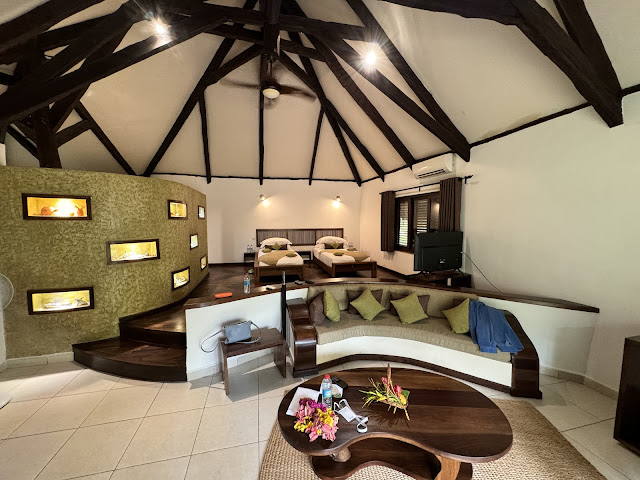














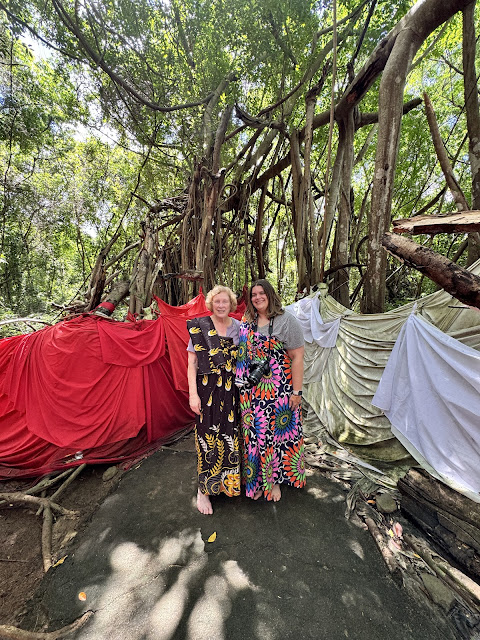


















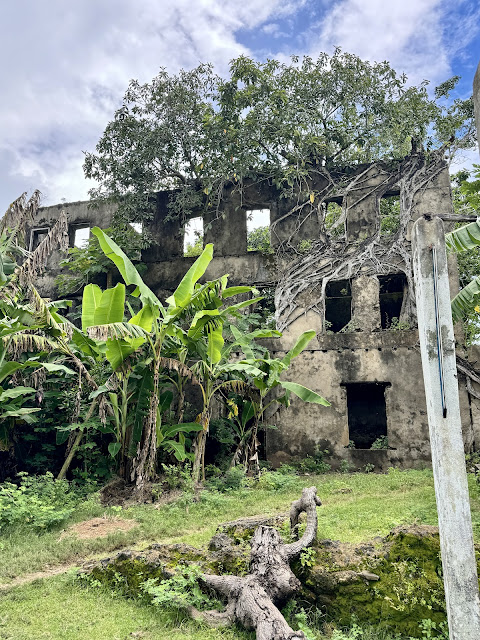







































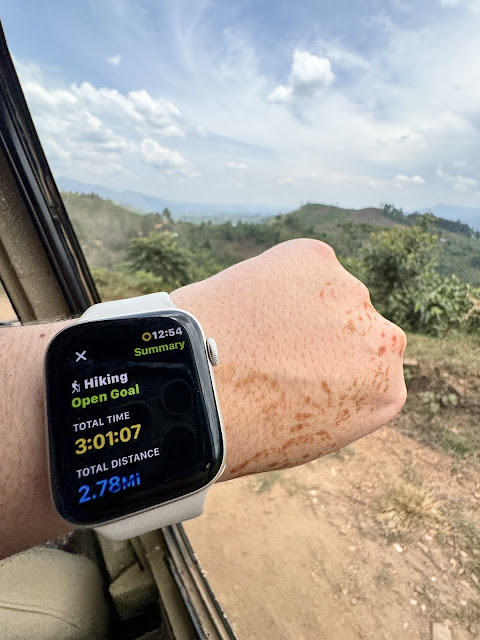















.jpg)


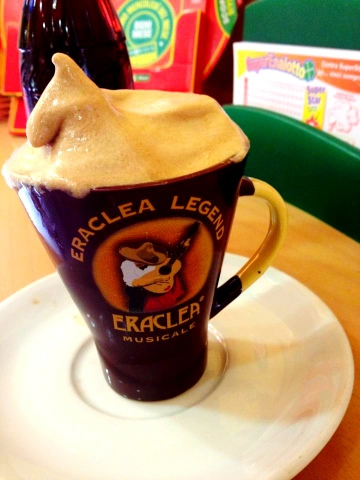

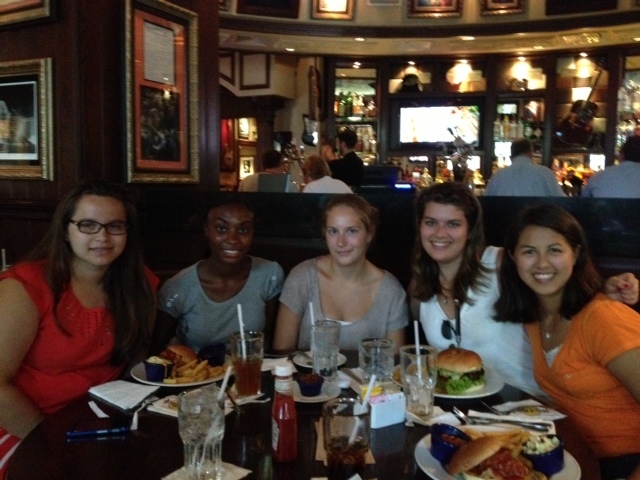

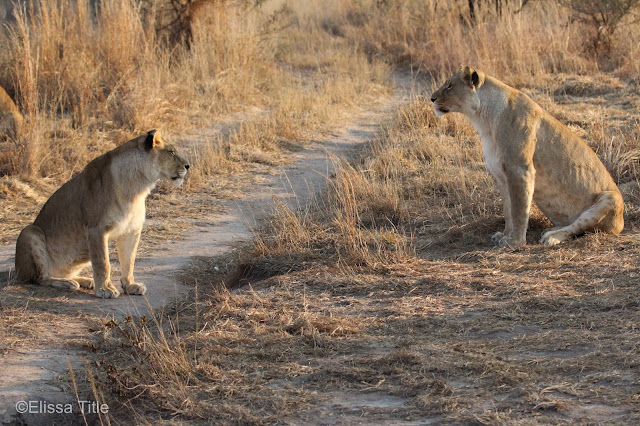
Comments
Post a Comment